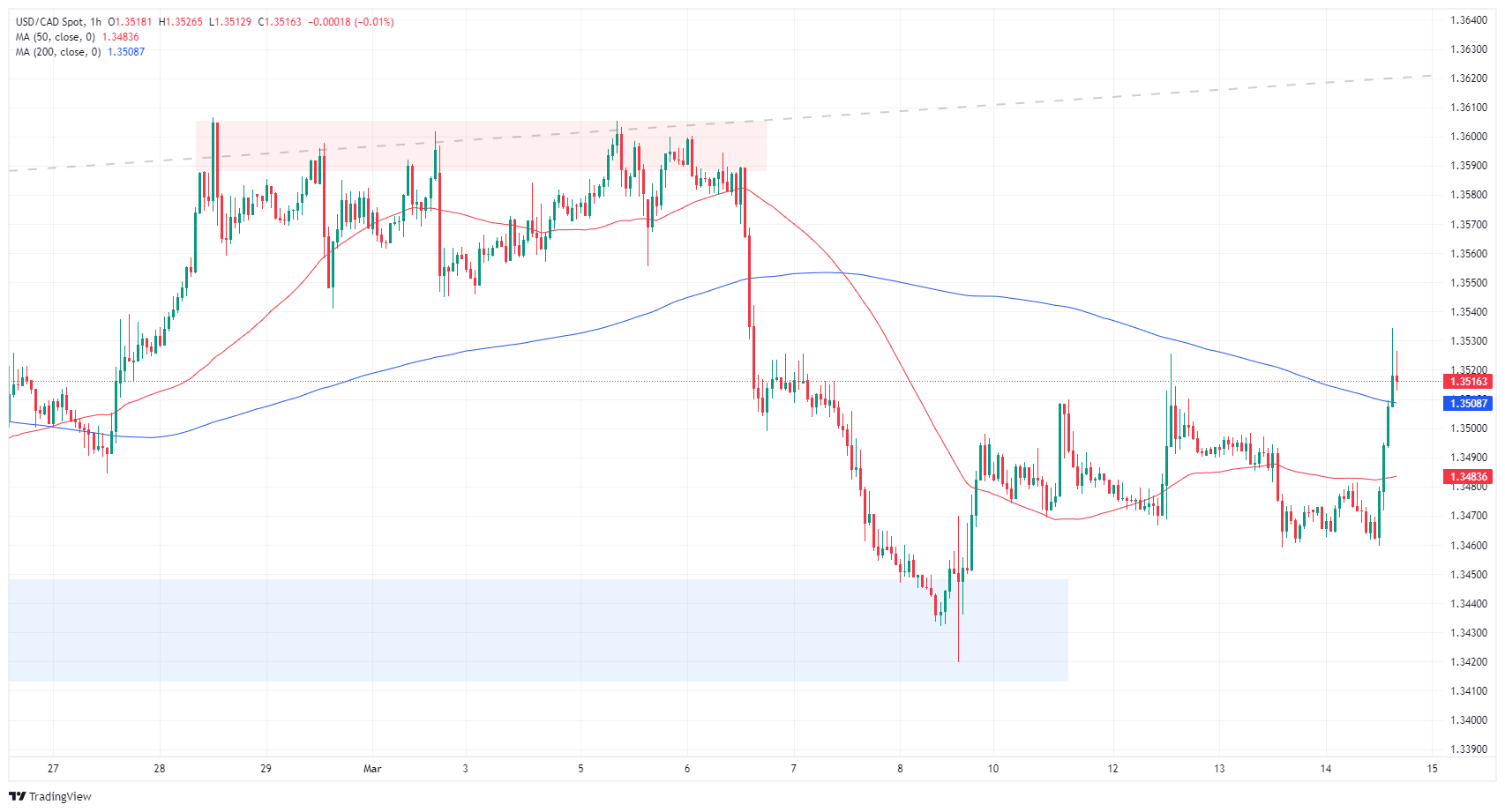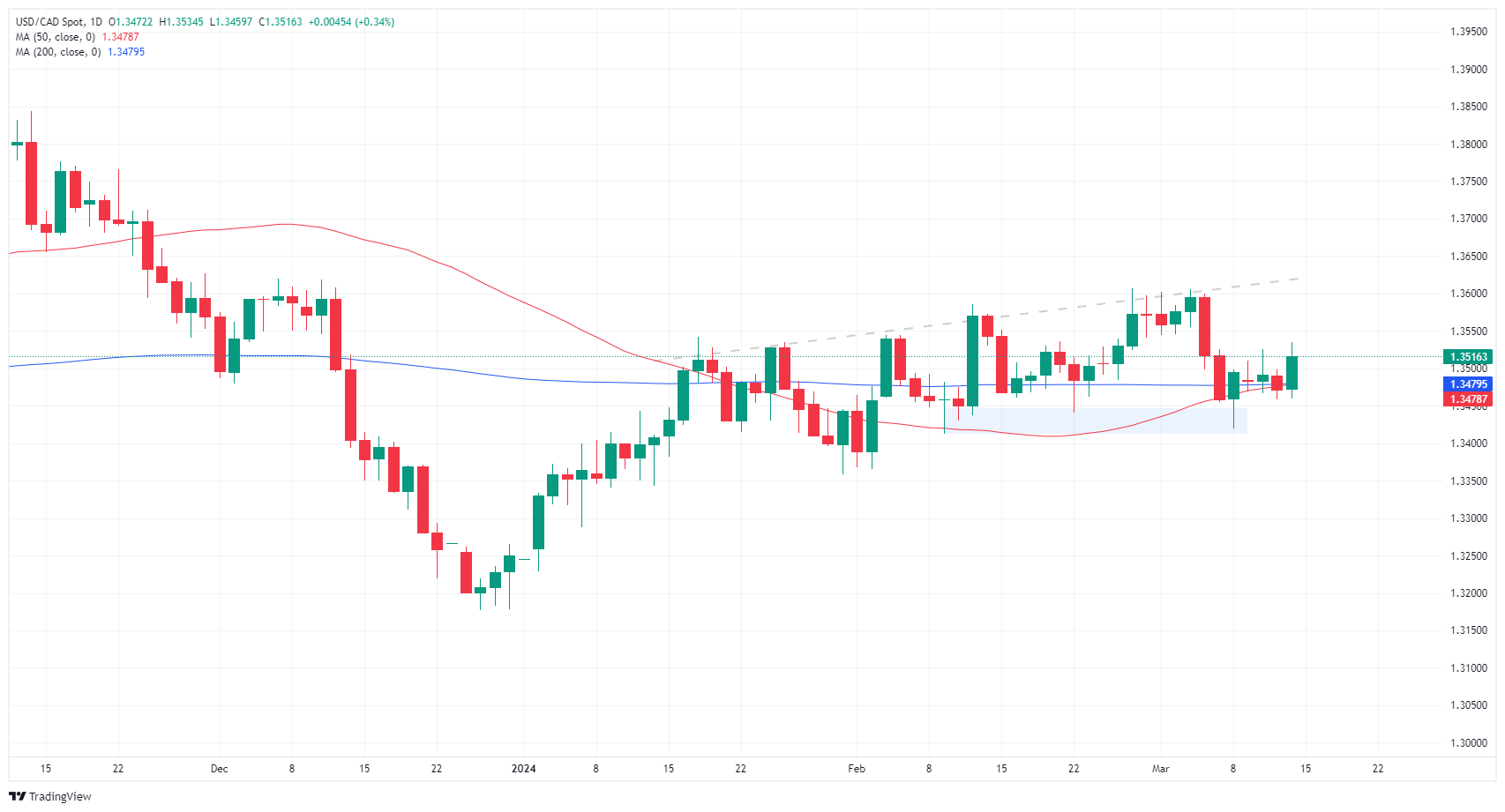- Analytics
- News and Tools
- Market News
- Canadian Dollar gets battered by Greenback after US Retail Sales miss on Thursday
Canadian Dollar gets battered by Greenback after US Retail Sales miss on Thursday
- Canadian Dollar gains against everything except the US Dollar.
- Canadian Manufacturing Sales barely register on the radar.
- Friday’s US UoM Consumer Sentiment in the barrel.
The Canadian Dollar (CAD) is broadly higher on Friday, landing in the green against the majority of its major currency peers but still shedding over half of a percent against the US Dollar (USD) bottom-to-top. Markets piled back into the Greenback bid after US Retail Sales missed the mark on Thursday, and the US Producer Price Index (PPI) stubbornly refused to give up ground.
Canada brought an update to January’s MoM Manufacturing Sales that barely registered in markets as investors focused squarely on US data and its impact on Federal Reserve (Fed) rate cut bets. On Thursday, following the US data dump, rate futures repriced slightly lower odds of a June rate trim from the Fed.
Daily digest market movers: US data kicks rate cut bets further back, US Dollar bids higher
- US Retail Sales in February missed expectations, rebounding to 0.6% MoM versus the forecast of 0.8%. However, this is still recovered from the previous -1.1% decline (revised lower from -0.8%).
- February’s US PPI showed producer-level inflation remains on the warm side, with YoY PPI holding steady at 2.0% instead of easing to 1.9% as markets expected.
- MoM US PPI eased to 0.3% from the previous 0.5% but failed to meet the market’s expected 0.2%.
- US Initial Jobless Claims also came in healthier than expected, with 209K new jobless benefits seekers for the week ended March 8 versus the forecast 218K. The previous week’s benefit seekers was also revised to 210K from 217K.
- The four-week average for Initial Jobless claims has dipped to 208K as the US labor market remains too tight to allow the Fed to cut rates as quickly and easily as markets were hoping for.
- Canadian Manufacturing Sales rebounded to 0.2% in January, missing the forecast 0.4% but still recovering from the previous month’s -1.1% decline (revised down from -0.7%).
Canadian Dollar price today
The table below shows the percentage change of Canadian Dollar (CAD) against listed major currencies today. Canadian Dollar was the strongest against the Australian Dollar.
| USD | EUR | GBP | CAD | AUD | JPY | NZD | CHF | |
| USD | 0.60% | 0.39% | 0.39% | 0.64% | 0.38% | 0.49% | 0.53% | |
| EUR | -0.61% | -0.22% | -0.23% | 0.03% | -0.23% | -0.13% | -0.08% | |
| GBP | -0.40% | 0.21% | -0.02% | 0.23% | -0.04% | 0.07% | 0.12% | |
| CAD | -0.39% | 0.24% | 0.03% | 0.26% | 0.00% | 0.10% | 0.15% | |
| AUD | -0.64% | -0.06% | -0.25% | -0.24% | -0.27% | -0.15% | -0.09% | |
| JPY | -0.38% | 0.24% | 0.03% | 0.00% | 0.29% | 0.12% | 0.16% | |
| NZD | -0.47% | 0.14% | -0.07% | -0.08% | 0.16% | -0.10% | 0.08% | |
| CHF | -0.52% | 0.08% | -0.12% | -0.14% | 0.13% | -0.14% | -0.04% |
The heat map shows percentage changes of major currencies against each other. The base currency is picked from the left column, while the quote currency is picked from the top row. For example, if you pick the Euro from the left column and move along the horizontal line to the Japanese Yen, the percentage change displayed in the box will represent EUR (base)/JPY (quote).
Technical analysis: Canadian Dollar broadly higher, but Greenback takes top spot on Thursday
The Canadian Dollar (CAD) is in the green against nearly all of its major currency peers, climbing a fifth of a percent against the Euro (EUR) and the Australian Dollar (AUD). The CAD is holding close to flat against the Japanese Yen (JPY) as the two battle for second place on Thursday, with the US Dollar the clear winner on the currency board. The Canadian Dollar is currently down around a third of a percent against the USD.
The USD/CAD rallied back over the 1.3500 handle as markets dog-piled back into the US Dollar, driving the pair into a fresh high for the week above 1.3530 and sending bids into battle with the 200-hour Simple Moving Average (SMA) near 1.3508. 1.3460 is the new intraday support level for sellers to beat, while a strong continuation into the top side will see a heavy supply zone near the 1.3600 handle.
Despite near-term gains, USD/CAD continues to wrestle with the 200-day SMA at 1.3480, cycling both sides of the major moving average for six straight trading days. The pair has consolidated around the 200-day SMA since rising into the 1.3500 neighborhood in January after a recovery from late December’s swing low below 1.3200.
USD/CAD hourly chart
USD/CAD daily chart
Canadian Dollar FAQs
The key factors driving the Canadian Dollar (CAD) are the level of interest rates set by the Bank of Canada (BoC), the price of Oil, Canada’s largest export, the health of its economy, inflation and the Trade Balance, which is the difference between the value of Canada’s exports versus its imports. Other factors include market sentiment – whether investors are taking on more risky assets (risk-on) or seeking safe-havens (risk-off) – with risk-on being CAD-positive. As its largest trading partner, the health of the US economy is also a key factor influencing the Canadian Dollar.
The Bank of Canada (BoC) has a significant influence on the Canadian Dollar by setting the level of interest rates that banks can lend to one another. This influences the level of interest rates for everyone. The main goal of the BoC is to maintain inflation at 1-3% by adjusting interest rates up or down. Relatively higher interest rates tend to be positive for the CAD. The Bank of Canada can also use quantitative easing and tightening to influence credit conditions, with the former CAD-negative and the latter CAD-positive.
The price of Oil is a key factor impacting the value of the Canadian Dollar. Petroleum is Canada’s biggest export, so Oil price tends to have an immediate impact on the CAD value. Generally, if Oil price rises CAD also goes up, as aggregate demand for the currency increases. The opposite is the case if the price of Oil falls. Higher Oil prices also tend to result in a greater likelihood of a positive Trade Balance, which is also supportive of the CAD.
While inflation had always traditionally been thought of as a negative factor for a currency since it lowers the value of money, the opposite has actually been the case in modern times with the relaxation of cross-border capital controls. Higher inflation tends to lead central banks to put up interest rates which attracts more capital inflows from global investors seeking a lucrative place to keep their money. This increases demand for the local currency, which in Canada’s case is the Canadian Dollar.
Macroeconomic data releases gauge the health of the economy and can have an impact on the Canadian Dollar. Indicators such as GDP, Manufacturing and Services PMIs, employment, and consumer sentiment surveys can all influence the direction of the CAD. A strong economy is good for the Canadian Dollar. Not only does it attract more foreign investment but it may encourage the Bank of Canada to put up interest rates, leading to a stronger currency. If economic data is weak, however, the CAD is likely to fall.
© 2000-2024. All rights reserved.
This site is managed by Teletrade D.J. LLC 2351 LLC 2022 (Euro House, Richmond Hill Road, Kingstown, VC0100, St. Vincent and the Grenadines).
The information on this website is for informational purposes only and does not constitute any investment advice.
The company does not serve or provide services to customers who are residents of the US, Canada, Iran, The Democratic People's Republic of Korea, Yemen and FATF blacklisted countries.
Making transactions on financial markets with marginal financial instruments opens up wide possibilities and allows investors who are willing to take risks to earn high profits, carrying a potentially high risk of losses at the same time. Therefore you should responsibly approach the issue of choosing the appropriate investment strategy, taking the available resources into account, before starting trading.
Use of the information: full or partial use of materials from this website must always be referenced to TeleTrade as the source of information. Use of the materials on the Internet must be accompanied by a hyperlink to teletrade.org. Automatic import of materials and information from this website is prohibited.
Please contact our PR department if you have any questions or need assistance at pr@teletrade.global.















